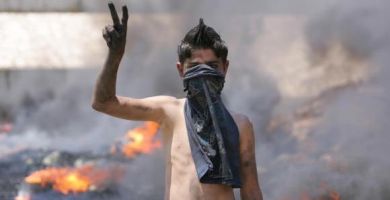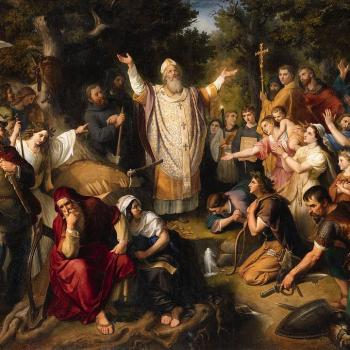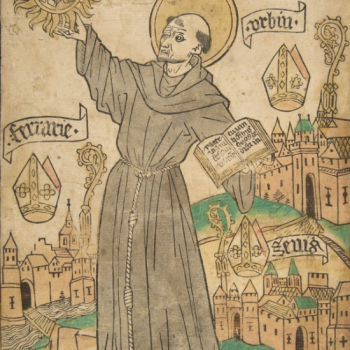Having a Voice in a Violent World
The movie “Miss Congeniality” (2000) presents the story of Gracie Hart, a FBI agent who goes undercover as a contestant in a beauty pageant in order to protect the contestants from a threat of violence. After learning how to dress, walk and act the part, and after wooing the audience with her amazing “glass harp” playing skills, Gracie finds herself doing quite well in the competition. She then has to answer a few personal questions about who she is and what she values.
Gracie is asked, “What is the one most important thing our society needs?”
She responds, “harsher punishment for parole violators.”
The crowd is silent
Sensing the awkward tension in the room Gracie adds, “And world peace!
The crowd cheers ecstatically
Politicians and polite society
Few would argue that world peace is not a noble goal to hope for, but discussing how to achieve “world peace” isn’t something many people are enthusiastic about discussing. The topic is difficult, and most communities would rather not have the discussion. There are few coffee shops which post their philosophy on international political engagement. I have yet to attend a sporting event where a presentation expounding the underpinning civic expectations of the star spangled banner are presented after the recitation of that celebrated bellicose ballad. When people gather together in communities war is rarely a reason, and seldom a concern. How to handle war, crime, punishment, and the “keeping of the peace” is left to those civil authorities who have been elected or appointed to do so. There is an assumption among polite society that these sorts of things aren’t to be discussed; leave that to the professionals.
Jesus and the Church
In the Gospel of Matthew the story of Jesus is told with a certain care by the author to do some deeply theological things. The sayings of Jesus are collected into five discourses[1] that many scholars think is a way of pointing to Jesus as one who embodies a “new Torah,” and who presents a way to live through which the kingdom of God is epitomized. In the first of these discourses Jesus opens with a list of beatitudes. One of them is, “Blessed are the peacemakers.” Similarly, in Luke’s Gospel the first thing that Jesus teaches comes from a quotation from Isaiah 61. This is often called Jesus’ “mission statement” by scholars.[2] In it Jesus states that he has come to do some radically political things like “proclaim freedom for the prisoners” and “set the oppressed free”.
Any reading of the scriptures quickly makes it clear that to be a follower of Jesus means that you need to be involved with addressing a violent world. Affirming that Jesus is the “prince of peace” (Isaiah 9:6) means that peace needs to be a primary concern to work for in the brass tacks of day to day life, not just a ideal to desire in the banal simplicity of beauty pageant philosophy. The Church has a unique role in the world. It lives somewhere in between polite society and civil authority. It has a voice, a concern, and a calling in the conversation concerning conflict, but remains distinct from the forces entrusted with the keeping of peace.
How should Christians think about and respond to violence?
Historically the church has recognised its unique voice in the conversation surrounding violence. Out of this concern have developed a number of different responses surrounding how a Christian should respond to living in a violent world, and what the role of the Church is in engaging the violence that surrounds it. There is no consensuses on what is the “best” way to respond to violence, but Christian theology does offer some common ground about violence itself which the Church can build off of.
A Christian Theology of Violence
Violence is something that is antithetical to the message of the Gospel. At the heart of Christianity is the belief that sin, death, and the Devil were defeated by God in the person of Jesus Christ. This was done by Jesus’ assumption of all of our humanity and all of our brokenness. Jesus suffered violence and death at the hands of men, and was raised up by the Father as a final vindication. Through this Jesus broke the power of sin and death over people so that we might live in God’s kingdom of peace. To cling to violence is to cling to a way of living that is contrary to the life that Christ offers those who are joined to him. The Church therefore has a vocation that declares that violence is a force that goes against the heart of God’s way of life. Even when the Church has supported violent resistance to violence it has viewed it as a lesser of two evils that should only be used with repentance and trepidation.
Christian Responses to Violence
In light of the Christian theology of violence people respond in a number of different ways. To examine how each of these perspectives plays out I will offer a controversial contemporary issue to act as lens through which we can view the various responses to violence. I would like to look at how the Church, which commonly views abortion as a terrible act of violence, responds to the rampant practice of abortion in the world today.
Peaceful Prevention
All historic Christian responses to violence affirm that the primary front in addressing violence is in the realm of prevention. No matter where you seek to prevent violence, there is work that can be done so that violence is not an issue that comes up. On a global scale these actions have been discussed in recent years through a set of practices that are thought to prevent war by Glen Harold Stassen in his book “Just Peacemaking.”[3] On the issue of abortion, there are are many views on how to end abortion. The World Health Organization has suggested that family planning initiatives, and education are the key ways forward to prevention.[4] Others have argued that offering social programs, child care, and foster family programs are the some of the best ways toward prevention.[5]The church has been an active participant in many of these efforts, although these efforts have been effective in lowering the number of abortions in many places abortions still occur all around the world. Preventative measures don’t always solve the problem entirely.
Violent Intervention as a Last Resort
If methods of prevention fail and violence has begun how to proceed becomes a very contentious issue. Some argue that if the only way to stop further violence is through violence than violent action should be taken. In matters of war the Catholic Church has developed a way to advise nations to when it is ethically acceptable to go to war. This is presented in “Just War Theory.” Just war theory can have more than one meaning but in all cases is concerned with constricting the valid causes for war, and restraining the actions of war.[6] In the words of my friend Alice, this perspective aims to assure that if a shot is fired, it is “shot accurately.”
A “Just War” response does not fit well into the church’s model for responding to violence in the face of many social issues. The Church is not “authorised”[7] like a government or law enforcement agency to uphold the peace through violent resistance. The proper response to issues of “personal violence”[8] is still hotly debated
In the abortion debate, some who oppose abortion have taken up violent actions in order to stop the violence they see being done to fetuses, believing that they are in a position to judge when violence is called for. For example, in a letter published in a Pensacola newspaper in 1984, a women claims responsibility for an abortion clinic bombing. In it she parallels her actions in the act of violence with the intervention by the United States Government in the violent slaughter of the Jews during World War II.[9] In cases like this the it is possible for the church to feel compelled to act violently still affirm the action is wrong. In light of a larger evil some churches have determined to respond with a lesser evil both in their council to civil authorities, and in some cases through violence themselves.
Non-violent Resistance
There are many groups of Christians who have decided that even if a violent response would be the lesser of two evils, they will not leave violence as an action. This group is generally known as “pacifists.”[10] A non-violent response finds it’s inspiration in the Cross of Christ. Jesus did not overcome evil with evil, but took on the violence of the world to the point of death on the cross. Non-violent resistance is grounded in the belief that Christian response to violence should imitate Christ, both in His non-violent reaction to violence, and in His creative activity. Many churches believe that violence is never a last resort, because they believe in a God of creation, who created creative people, who in tern can create new ways forward. This response to violence always seeks to bring a different language to the conversation.
In the abortion discussion non-violent resistance can be seen in those who keep vigil around clinics quietly praying the rosary, or those who offer masses for the aborted fetuses found in dumpsters.[11] These actions seek to confront the purveyors of violence but to not succumb to the violence themselves.
Continuing the Conversation
Being a follower of Jesus means that we should not be content to let peace be simply a goal simply affirmed, but one that is lived. It seems impossible to create a script for how to respond to violence in every given situations. We live in a world that presents new horrors and disfigurations every day that shatter the peace that we seek. Violence is never a problem with an easy answer.
The church exists to affirm that God’s answer to the problem of violence was the most difficult answer imaginable; while we were yet sinners Christ died for us.[12] Christians have a unique hope; although in the world we can see sin death, and the Devil, we know that those powers have already been defeated. The church’s response to violence must have its foundation in its vocation to partner with God to manifest that reality in every place on earth. This is why I am much more comfortable standing with those who resist with prayer and worship, then those who respond with bombs and bloodshed. I believe that the real hope of the church is in the Holy Spirit that guides it. In Genesis 1 the Spirit hovered over the primordial waters of chaos and created something utterly original. I believe that the church, guided by that same Spirit, can help create new solutions to conquer the chaos of violence in the world today.
[1]Cooke, Richard. New Testament . (London: SCM Press, 2009), 100.
[2]Green, Joel B.. The Gospel of Luke . (Grand Rapids, Mich.: W.B. Eerdmans Pub. Co., 1997),379.
[3]Stassen, Glen Harold. Just peacemaking: the new paradigm for the ethics of peace and war. New ed. (Cleveland: Pilgrim Press, 2008).
[4]Complications of abortion: technical and managerial guidelines for prevention and treatment.. (Geneva: World Health Organization, 1995), 115.
[5]Steiner, Gilbert Y.. The abortion dispute and the American system . (Washington, D.C.: Brookings Institution, 1983), 49.
[6]Cahill, Lisa Sowle. Love your enemies: discipleship, pacifism, and just war theory. (Minneapolis: Fortress, 1994), 1-2.
[7]According to Just War Theory
[8]This kind of violence covers a wide rage. Things like domestic abuse, robbery, rape, etc. There are many cases of violence which are not dealt with by a political body.
[9]Condit, Celeste Michelle. Decoding abortion rhetoric: communicating social change. (Urbana: University of Illinois Press, 1990), 218.
[10]These are not hard categories. Augustine, who is the most influential proponent of “Just War Theory” actually believed that PERSONAL violence was always wrong:
Chiba, Shin, and Thomas J. Schoenbaum. Peace movements and pacifism after September 11. (Cheltenham, UK: Edward Elgar, 2008), 78.
[11]For footage from one of these funerals go to http://www.vimeo.com/6526349
[12]Romans 5:8













